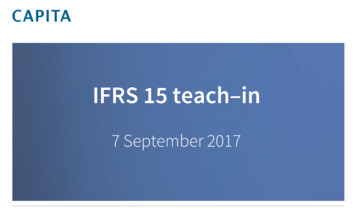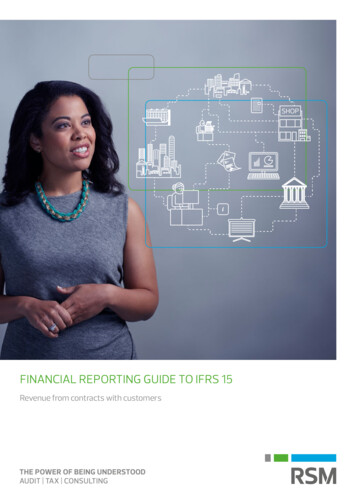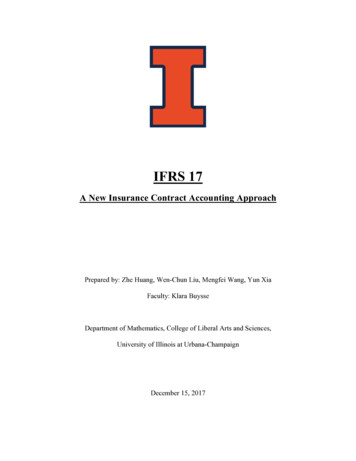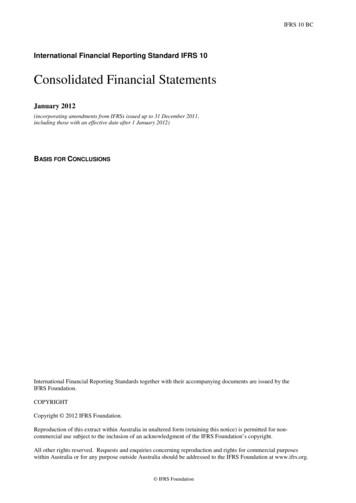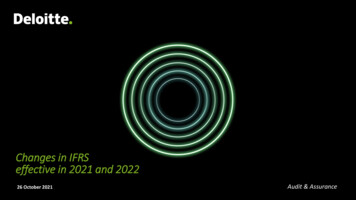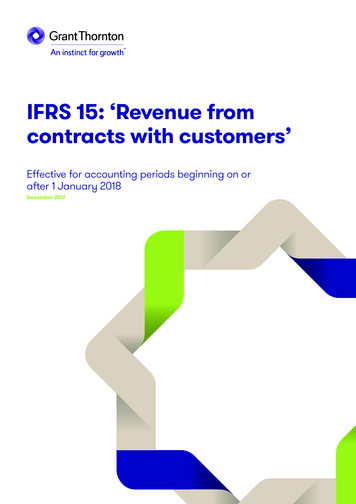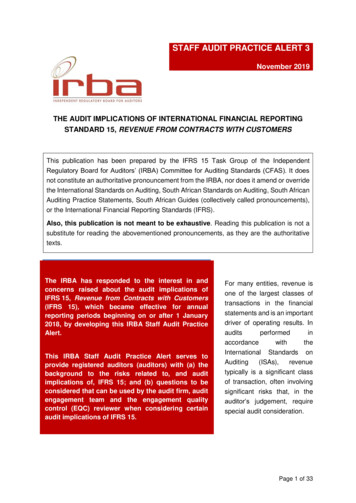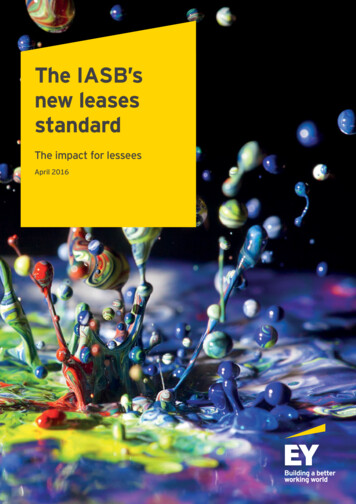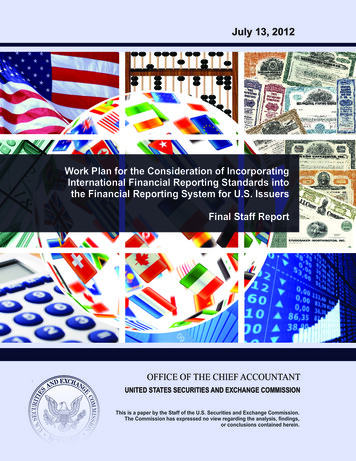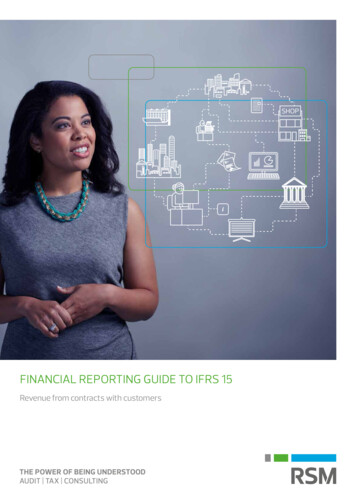
Transcription
FINANCIAL REPORTING GUIDE TO IFRS 15Revenue from contracts with customers
CONTENTSSection 1Applying the changes in IFRS 156Step 1: Identify the contract(s) with a customer6Step 2: Identify the performance obligations in the contract7Step 3: Determine the transaction price8Step 4: Allocate the transaction price to the performance obligationsin the contract8Step 5: Recognise revenue when (or as) the entity satisfies aperformance obligation9Section 2What disclosures are required?10Section 3Transition decisions12Section 4Dealing with areas of judgement16Secton 5Clarifying amendments made April 201620Identifying performance obligations20Principal vs agent considerations22Licensing23How can RSM help?24
INTRODUCTIONIn May 2014, the International Accounting Standards Board (IASB)published IFRS 15 which replaces IAS 18 Revenue, IAS 11 ConstructionContracts and their associated Interpretations.Developed in conjunction with the US GAAP standard Topic 606, IFRS 15seeks to remove inconsistencies and weaknesses in previous revenuerequirements, provide a more robust framework and improve comparabilityof revenue recognition practices across entities, industries, jurisdictions andcapital markets. It is intended to provide more useful information to users offinancial statements through improved disclosure requirements and to simplifythe preparation of financial statements by reducing the number of separatedocuments to which an entity must refer.under IFRS 15 (and looks at some of the practical implications), the two transitionmethods (together with their comparative advantages and disadvantages)and available practical expedients. In addition, it includes a detailed look at thedisclosures that will need to be provided under the new standard.STEP 1How will it impact?Identify the contract(s)with a customeron the nature and terms of their customer contracts. Current contract terms (explicit and implicit) and businesspractices may need to be reconsidered in order to avoidunintended consequences.Identify the performanceobligations in the contract Estimates and judgements previously made in the absenceof specific financial reporting guidance may need to berevised to comply with the specific guidance given byIFRS 15. For example: where it is necessary to allocatea transaction price between the goods/services it haspromised to deliver (‘performance obligations’), an entity willneed to consider whether its existing allocation method isconsistent with the specific hierarchy of possible methodsset out in IFRS 15.STEP 3 STEP 2Determine thetransaction priceclarify some of its requirements and provide additional transitional relief (see section 5).When is it effective?IFRS 15 comes into effect for periods commencing on or after 1 January 2018 withearly adoption of the main standard permitted as long as that fact is disclosed.In a nutshellIFRS 15 sets out a single framework for revenue recognition. Its core principle is thatan entity recognises revenue to depict the transfer of promised goods or servicesto customers in an amount that reflects the consideration to which the entityexpects to be entitled in exchange for those goods or services. IFRS 15 sets outfive key steps to follow in applying this core principle.Additional guidanceIFRS 15 also contains guidance on accounting for certain contract costs, paymentsto customers, and a cohesive set of disclosure requirements for revenue andassociated contract balances.4 STEP 4Allocate the transactionprice to the performanceobligations in the contractSTEP 5Recognise revenue when(or as) the entity satisfiesa performance obligationlikely to affect entities which provide a bundle of goodsand services, or provide licences, or for those for whomconsideration receivable is variable in nature eg because ofdiscounts, rebates and other price concessions, incentivesand performance bonuses, penalties or other similar items.there is only one performance obligation, particularly forthose involved in providing services. Entities will need todetermine whether revenue should be recognised over timeor at a point in time. Existing accounting software may need to be adapted orreplaced to ensure it is capable of capturing data to deal withthe new accounting requirements; particularly for use inmaking estimates or supporting the extensive disclosures.Entities should carefully consider as soon as possible the impactof the available transitional options and practical expedientson reported profit, covenant arrangements, dividend policy,performance related remuneration and narrative reporting.5
Step 2: Identify the performance obligations in the contract assessment of promises in the contract (explicit orimplied) to determine what, and how many, performanceobligations exist. Some promises may not lead toperformance obligations (see section 4). Once the promises have been identified, an entity needsto consider whether they are performance obligations. A performance obligation may be a promise to transfera single ‘distinct’ good/service, a ‘distinct’ bundle ofgoods/services, or a ‘series’ of ‘distinct’ goods/services.1Good/service iscapable of beingdistinctPromise ionsAPPLYING THE CHANGES IN IFRS 15IFRS 15 addresses revenue from contracts with customers and so is only applied to acontract in its scope if the counterparty to the contract is a customer.IFRS 15 specifically excludes collaborative (and certain other) agreements, eg two companies agreeto collaborate on the development of a new drug, from its scope. However, such agreements cansometimes contain a vendor-customer relationship component and so judgement may be required todetermine whether IFRS 15 should be applied to certain collaborative arrangements from its scope wherethe collaborator or partner meets the definition of a customer for at least some of the arrangement.Step 1: Identify the contract(s) with a customer An entity only accounts for a contract when it meets all of the following five specified criteria:» It has been agreed by its parties, who are committed to perform their respective obligations;» it identifies each party’s rights regarding the goods or services to be transferred;» it identifies the payment terms;» it has commercial substance; and» it is probable that the entity will collect the consideration to which it will be entitled in exchange for thegoods or services that will be transferred to the customer. Termination rights can affect the duration of a contract (IFRS 15.11-12). A contract can only exist tothe extent the parties have present enforceable rights and obligations. Individual contracts entered into at or near to each other with the same customer may need to becombined for accounting purposes, when one or more of the three specified criteria in IFRS 15.17 are met.A good/service is capable of being distinct if thecustomer can benefit from it (eg by use, consumptionor sale) either on its own or together with otherresources readily available to the customer (eg thosealready owned, or which can be acquired from theentity or another entity).For example: if an entity sold a TV package thatincluded a television and DVD player, these wouldbe considered distinct goods because the televisionis capable of being used by the customer withoutthe DVD player. Whilst the DVD player could notbe used without the television, the customercould obtain an alternative television from anothersupplier or use their existing television. Some contracts provide a customer with an option toacquire additional goods/services in the future, oftenat a discount or even for free. These options comein many forms including sales incentives, loyaltyprogrammes and renewals. Such options must nowbe assessed to determine whether they provide thecustomer with a ‘material right’. If they do, that right(but not the underlying additional goods/services)is a performance obligation. This is an area where weexpect to see an additional performance obligationcompared to legacy IFRS. We also expect the need forjudgement (see section 4).In assessing whether a promise isseparately identifiable, an entityconsiders whether the nature of itspromise is to transfer each promisedgood/service individually or instead totransfer a combined item(s).trip up the unwary, and is considered inmore detail in section 5. A ‘portfolio’ approach may be possible, in specifiedcircumstances, for similar performance obligationsacross multiple customers for accounting purposes.(see section 4). Special rules apply to the subsequent accounting for a contract where its scope or price (or both) aredistinctness of the new goods/services added or remaining performance obligations (IFRS 15.20-21).6Note:assessing whether a promise is separately identifiablestep have been clarified (see section 5).7
Step 3: Determine the transaction price the contract is fulfilled in accordance with its terms andcustomary business practices, and is not cancelled,renewed or modified. Variable consideration is included in the transaction priceusing either ‘expected value’ or ‘most likely amount’, butprevent too much revenue being recognised when it is toouncertain and runs the highly probable risk of resulting ina significant reversal. IFRS 15 .57 sets out some factorsthat may help with this determination. An exception applies to sales or usage based royaltiesreceivable from a licence for the use of IntellectualProperty (IP) (or where the IP is the predominant item inthe contract) (IFRS 15.B63). (more details in section 5). IFRS 15 contains specific guidance on accounting forsome of the causes of variability in a transaction price ierefunds/sales with a right of return and ‘breakage’ (IFRS15.B20-B27 and B44-47). Significant financing benefits are taken into account(subject to a practical expedient) not only when an entityprovides credit to its customers but, also when it receivesa benefit due to payments received in advance(IFRS 15.60-65). Non-cash consideration is measured at fair value andvariability in this is only taken into account when it arisesdue to reasons other than the form of the consideration(eg a change in the exercise price of a share option due tothe entity’s performance). Sometimes an entity pays consideration to its customer,might be in the form of cash in exchange for goods orservices received from the customer (eg slotting feespaid to a retail customer), or the provision of a creditsuch as a voucher or coupon for goods or services to beprovided to the customer or end consumer (eg moneyoff coupons against future purchases by consumers),or a combination of both. IFRS 15 requires an entity todetermine whether the consideration payable is for a‘distinct’ good or service; a reduction of the contract’stransaction price; or a combination of both. Considerationpayable is only accounted for as an expense (in the sameway as for other purchases from suppliers), rather thanas a reduction in revenue, if the entity receives a good orservice that is ‘distinct’.Note: Some of the requirements of this step have beenclarified (see section 5).8Step 4: Allocate the transaction price to the performanceobligations in the contract When a contract comprises more than one performanceobligation, the transaction price is allocated to eachobligation on the basis of directly observable standalone selling prices (determined only at contractinception and not changed). Exceptions exist for allocating discounts and variableconsideration that can be shown to be related to one ormore but not all performance obligations (IFRS 15.81-86). Step 5: Recognise revenue when (or as) the entity satisfies a performance obligation as principal or agent (see section 5). Timing of revenue recognition requires the evaluation of whether control transfers (and thereforethe performance obligation is satisfied) over time or at a point in time. If a performance obligation isnot satisfied over time, then it is satisfied at a point in time.Revenue recognition over timeA performance obligation is satisfied over time if any of the following criteria are met:absence of a directly observable stand-alone selling price(IFRS 15.76-80):» An adjusted market assessment;» expected cost plus a margin; or» a residual approach. Specific rules apply if the transaction price changes,depending on the reason for the change ie the resolutionof an uncertainty or as a result of a contract modification(IFRS 15.87) Specific guidance is provided in respect of warranties(IFRS 15.B28-B33). A distinction is made between thosewarranties which provide the customer with a service(‘service-type warranty’) in addition to the assuranceor guarantee that the related product/service complieswith the agreed-upon specifications (‘assurancetype warranty’). If a warranty is separately priced ornegotiated then it is a distinct service and therefore aperformance obligation. If not, then an entity will need toassess whether the warranty it is supplying provides thecustomer with a service in addition to a guarantee. IFRS 15 provides guidance on making this assessment,which takes into account whether the warranty isrequired by law, the length of its coverage period, andthe tasks the entity promises to perform under it. Whena service warranty is provided, an entity allocates thetransaction price between the related product/serviceand the warranty service using the allocation guidancenoted above. Current practice may change under IFRS15 in respect of service-type warranties dependingon judgements made in applying the warranty-typeassessment guidance, and the guidance on allocatingtransaction prices. However, in respect of assurancetype warranties current practice is unaffected.Customer simultaneouslyreceives and consumes thebenefits provided by the entity'sperformance as the entityperforms.creates or enhances an asset. that the customer controlsas the asset is created orenhanced.performance doesnot create an asset withan alternative use to theentity AND the entity has anenforceable right to paymentfor performance completedto date. Additional guidance is provided in respect of licenses todetermine whether revenue should be recognised overtime or a point in time. Where a licence is a separateperformance obligation, an entity considers whether itspromise is to provide the customer with either a ‘right toaccess’ the entity’s IP, or a ‘right to use’ the IP as it existsat the point the licence is granted. A ‘right to access’ is anobligation that is satisfied over time, and a ‘right to use’ issatisfied at a point in time. In making this assessment, the entity is required toconsider different criteria to those applied to othernecessary in the case of licences because it is difficultto assess when the customer obtains control of assetsin a licence (as they could be changing) without firstidentifying the nature of the entity’s performanceobligation. Essentially these criteria require an entity toconsider whether its activities significantly affect the IPto which the customer has rights. If they do, and thoseactivities are not a separate performance obligation intheir own right, then an entity is providing access to its IPover time. (See section 5 for more details). If a licence is not distinct, then it is accounted for byevaluating when control transfers. A method must be selected by which to measure anentity’s progress towards satisfying a performanceobligation over time. IFRS 15 contains guidance on bothoutput and input methods but ultimately it will be theentity’s judgement call as to which method providesthe most reasonable and reliable estimate of themeasure of its progress. Where an output method is most appropriate, a ‘rightto invoice’ practical expedient may be applied whenthis invoicing corresponds directly with the value ofeach incremental good/service that is transferred tothe customer (eg a fixed hourly rate for each hour ofservice provided).Accounting for certain contract costs Incremental costs of obtaining a contract that areexpected to be recovered must be recognised as anasset unless the amortisation period would be oneyear or less, in which case they can be expensed asa practical expedient. Costs incurred in fulfilling a contract that are not inthe scope of another standard must be recognisedas an asset if they meet all three specified criteria:» Directly attributable to a specific contract orspecific anticipated contract;» generate or enhance resources to be used in thefuture in satisfying performance obligations; and» be expected to be recovered.consistent with the transfer of those goods/services tothe customer to which the costs relate.9
Summary of information requirements2RevenueContractsSignificant judgementsDisaggregation of revenueInformation about contractTiming and methods(input or output) of recognitionInformation about performanceobligationsDetermining transaction priceand allocating to performanceobligationsAmounts allocated to remainingperformance obligationsCosts to obtain or fulfil contractsRevenue from openingcontract liabilityAmounts recognised relating toperformance in previous periodsWHAT DISCLOSURES ARE REQUIRED?It is important not to underestimate the importance of the disclosure requirements ingoals of the IASB and the FASB was to provide users of financial statements with moreuseful information through improved disclosure about an entity’s revenues.Disclosure objectiveTo enable users of financial statements to understand the nature,amount, timing and uncertainty of revenue and cash flows.Although the disclosure requirements are extensive (more than previously required), they are notprescriptive; rather, they require the disclosure of quantitative and qualitative information about: thenature of the entity’s revenues; how much is recognised and when; and any uncertainties about thoserevenues and related cash flows.An entity is not expected to make disclosures that are irrelevant or immaterial to them, or to duplicatedisclosures made elsewhere in the financial statements (in accordance with other IFRS standard).balances and changesDisaggregation of revenueDisaggregation of revenue is a key disclosure. It will requiredecisions to be made about how revenues should beanalysed. Whilst there is guidance in appendix B of IFRS 15and the accompanying illustrative examples indicate howsuch disclosures may look, it is important to remember thatthese are simply examples, and that in order to meet thedisclosure objective, and be effective, the categories chosenfor the analysis should take into account your users’ needs.reflect the entity’s business model and depict the effect ofcan tell from the disclosures what the entity actually does.Furthermore, such disclosures ought to be consistentwith other communications an entity makes about itsrevenues (eg press releases, other public filings, narrativereports included with the financial statements), and mustbe reconcilable with any disclosures made under IFRS 8Operating Segments. It may be that the IFRS 8 disclosuresare already sufficient to meet the disclosure objective inIFRS 15 concerning disaggregation, but this will need to beconsidered by each entity.Significant judgementsIt is useful for users of the financial statements to understandif significant judgements have been made in determiningwhen and how much revenue should be recognised. Clearlysome judgement will always be necessary by all entitieswhen applying the standard, but what these disclosuresshould do is enable the user to understand where significantjudgements, or changes in judgements, have been necessaryin applying IFRS 15 to the entity’s specific contracts.Practical expedientsTo aid comparison with other entities, the use of anypractical expedients used in determining revenuerecognition must be disclosed.disclosures, sometimes referred to as the ‘Backlog practicalexpedient’. Disclosure about amounts allocated to remainingperformance obligations is not required if either: has an original expected duration of one year or less(because such information is only relevant when acontract is long-term); or revenue is recognised from the satisfaction of theperformance obligation as it is invoiced in accordancewith the ‘right-to-invoice’ practical expedient(see section 1, step 5).1011
3TRANSITION DECISIONSFull retrospective method31 December reporting date, applying IFRS 15 from its mandatory effective date of1 January 2018.Both methods require retrospective application, but rather than requiring restatement of comparatives,the Cumulative catch-up method requires the cumulative effect of initially applying IFRS 15 to be adjustedagainst opening reserves at the beginning of the period in which it is first applied, with comparatives leftas previously reported under legacy IFRS.Transition methodsFULL RETROSPECTIVE(Five optional practical expedients)Retrospective with cumulative catch upat date of initial application (One optionalpractical expedient)Current year(2018)Current yeardisclosures12Contracts not restatedAll contracts under new StandardContracts restated, except where practicalexpedients appliedDisclose expedients used and qualitativeassessment of estimated effect to the extentreasonably possiblePractical expedients on transition - full retrospective method1. No need to restate completed contracts (as defined inIFRS 15.C2.b) that begin and end within the same annualreporting period.have to be restated so significantly reduces the burdenwhen an entity has a lot of short-term contracts but: It may result in a lack of comparability with the currentperiod; and it may also lead to a lack of comparabilityif interim reporting.Cumulative catch- upPrevious year(2017)shows the trend in revenue. It may be costly and onerous for some entities but five practical expedientsare available which either reduce the number of contracts that need to be restated on transition orsimplify the restatement by allowing the use of hindsight.Cumulative catch- upExisting uncompleted/completed contractsand new contracts under new StandardImpact of IFRS 15 compared to legacystandard for each line item affected2. No need to restate completed contracts (as defined in IFRS15.C2.b) at the beginning of the earliest period presented.which have to be restated and therefore the level ofcost and effort involved.4. Apply hindsight and recognise the aggregate effect ofmodifications since contract inception at the beginningof the earliest period presented rather than assessingand accounting for each modification.accounting for multi-year contracts that have beenmodified many times prior to adopting IFRS 15.5. No need to disclose the amount of the transaction priceallocated to the remaining performance obligations andan explanation of when the entity expects to recognisethat amount as revenue for comparative periods.useful information since it is out of date, and it wouldrequire significant use of hindsight to estimate thetransaction price and expected timing.3. May apply hindsight and use the actual transaction price oncompletion rather than estimating variable considerationamounts in the comparative reporting periods forcompleted contracts that have variable consideration.13
Cumulative catch-up methodcostly and onerous but, because the cumulative effect isadjusted against opening reserves and the comparativesremain as reported under legacy IFRS, there will be a lackdisclosures and simply being able to elect to use this methodcould result in a lack of comparability with an entity’s peers.under which the entity has already fully performed but hasnot recognised all of the revenue (perhaps because it wascontingent). Under the cumulative catch-up method, anentity has a choice between: Recognising the remaining revenue under existinglegacy accounting policies and only applying IFRS 15 toincomplete and new contracts, or restating completed contracts under IFRS 15 so that IFRS15 is applied to all contracts.to maintain two accounting systems, but on the flipside, inpractice the number of completed contracts ought not to bean issue for most entities.Practical expedients on transition - cumulativecatch-up methodKey points to consider on transition Explore the differences between the two transition methodsbefore making a decision, including the disclosures that willbe needed for each method. Consider the use of practical expedients on transition, asthese could make the process easier and so influence thedecision between the two methods. Consider how the disclosure objective can best be met.Even if the numbers cannot be populated at this stage,decisions about how revenue should be disaggregated canstill be made. It may be helpful to discuss the possibilitieswith key stakeholders to ensure that their needs andexpectations will be met, and will be consistent with existingcommunications about revenues. Don’t be afraid to challenge current revenue recognitionpolicies – transition is an opportunity to take a fresh look,taking the time to fully understand the contractual termsand conditions applying to revenue transactions. Build time into the transition process to fully understandthe disclosure requirements, which are more extensive thanunder legacy IFRS. Don’t underestimate the challenge the disclosurerequirements may present (for example if operating inmultiple segments with different product or service lines). Be aware that systems may need to be changed to capturethe necessary detail for disclosure, or to allocate transactionprices and these will need to be implemented and testedsooner rather than later.May use hindsight, and recognise the aggregate effectof modifications at: not having to wait until initial application); or the date of initial application of IFRS 15.accounting for multi-year contracts that have beenmodified many times prior to adopting IFRS 15.1415
4Identifying the performance obligations - assessingthe nature of an entity’s promiseUnder IFRS 15, an entity is required to assess thepromises in its contracts to determine whetherthey are performance obligations. However, itmay not always be the case that certain promisesare performance obligations, or that they needbe assessed to determine whether they are. Forexample: Do certain promises actually represent aperformance obligation or are they simply a fulfilmentactivity? Are they immaterial? What about preproduction activities?It may be tempting to assume that all promises ina contract are a performance obligation, however,the concept of assessing promises to determine theperformance obligations is not expected to resultin many more than would have been identified asdeliverables under legacy IFRS.DEALING WITH AREAS OF JUDGEMENTIFRS 15 is a comprehensive and complex standard andentities may find that its detailed guidance conflicts withcertain judgements and interpretations made when applyinglegacy IFRS. Furthermore, whilst IFRS 15 is intended toremove inconsistencies and improve comparability, thereremains considerable scope for judgement.Applying the ‘portfolio approach’applied at a portfolio level for contracts (or performanceobligations) with similar characteristics rather than on acontract-by-contract basis. However, its use is conditional onit being reasonably expected that the effects on the financialstatements of applying IFRS 15 to the portfolio will not differmaterially from applying it to the individual contracts (orperformance obligations) within that portfolio.Other than stating when the approach may be used, and itbeing clear from the Basis for Conclusions that it is intendedfor very large populations, there is no further reference to theportfolio approach within the standard.It will therefore be necessary for entities to use their judgement: To evaluate what ‘similar characteristics’ constitute aportfolio (eg the impact of different offerings, periods oftime, or geographic locations); in deciding how large the population should be; in assessing when the portfolio approach may beappropriate; and in deciding to what stage(s) of the revenue recognitionprocess it applies.16IFRS 15 provides no guidance on how to assess whether theoutcome of using the approach is similar to that which wouldresult if the contracts were assessed individually, nor the extentto which it is necessary to go to make that assessment.As an alternative to using the portfolio approach, it maybe easier for some entities to instead use a portfolio oftransactions as a source of data to develop estimates toapply to individual contracts.Activities that an entity must undertake in orderto fulfil a contract are not performance obligationsunless they transfer a good/service to the customer.For example, both the promise to provide a customerstatement on a periodic basis and a promise toprovide a hotline to answer customers’ questionsabout a product would be fulfilment activities withrespect to a promise to sell a service/good rather thana separate performance obligation in their own right.Furthermore, any benefit these promises provide tothe customer is likely to be viewed by the customer asminor and, consistently with IFRS generally, immaterialitems/promises need not be considered.On the other hand, determining whether a preproduction activity is a fulfilment activity or aperformance obligation will require more judgement.ExampleConsider a long-term production contract whichincludes some up-front engineering and design.To assess whether it is an activity to fulfilthe production contract or a separateperformance obligation in its own right, it maybe helpful to apply the criteria for determiningwhen an entity transfers control of a good orservice over time. In other words, determinewhether the customer is simultaneouslyobtaining control of something as the entityundertakes the pre-production activities.In this scenario, if the customer obtained theproduct from the contract and obtains the IP(patents) from the engineering and designactivities, these would be considered as twoseparate performanc
the contract) (IFRS 15.B63). (more details in section 5). IFRS 15 contains specific guidance on accounting for some of the causes of variability in a transaction price ie refunds/sales with a right of return and ‘breakage’ (IFRS 15.B20-B27 and B44-47). (IFRS 15

